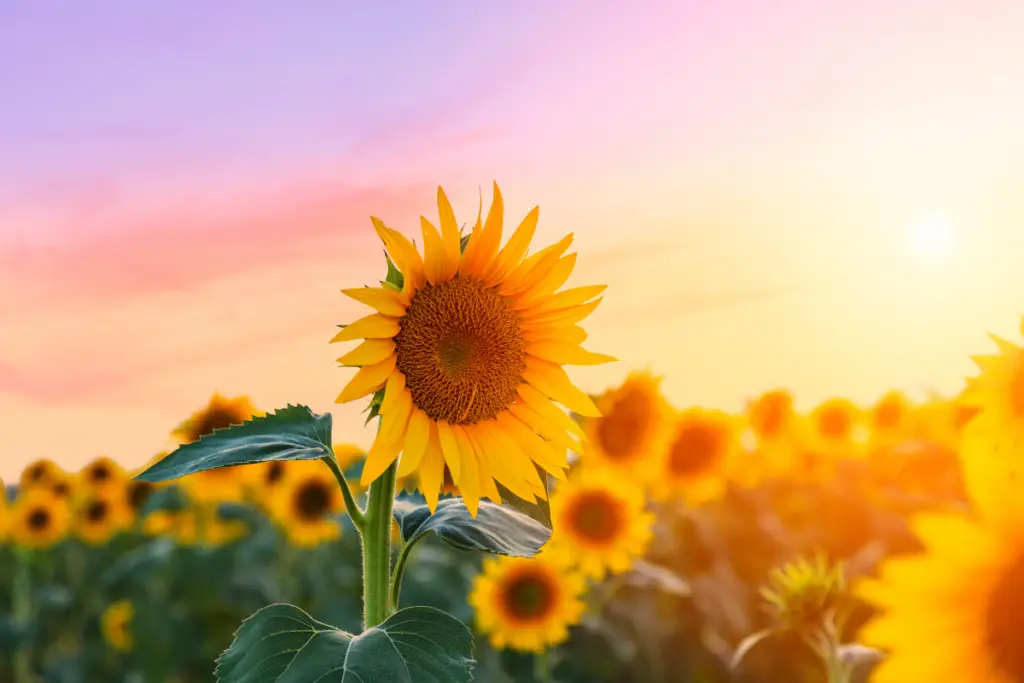Sunflowers are a popular choice for gardens and landscapes due to their vibrant colors and towering heights.
But many gardeners wonder whether sunflowers come back every year. The answer is that it depends on the type of sunflower.
Annual sunflowers, such as the common Helianthus annuus, complete their life cycle in one growing season and do not come back the following year.
On the other hand, perennial sunflowers, such as the Helianthus decapetalus, can return year after year from the same plant.
However, it’s important to note that not all perennial sunflowers are reliably hardy in all regions, and some may require extra care to survive the winter.
For those looking to plant sunflowers that come back every year, there are several perennial varieties to choose from.
These include the Helianthus maximiliani, Helianthus salicifolius, and Helianthus tuberosus, among others.
By selecting the right type of sunflower and providing proper care, gardeners can enjoy the beauty of these plants for years to come.

Table of Contents
The Life Cycle of Sunflowers
Sunflowers are a popular garden plant known for their bright yellow petals and large, circular heads.
They are a member of the daisy family and can grow up to 10 feet tall.
Sunflowers are generally categorized into two groups: annuals and perennials.
Annual sunflowers complete their entire lifecycle in one growing season, meaning they grow from seed, bloom, produce seeds, and then die within a year.
Perennial sunflowers, on the other hand, can live for several years and come back year after year under the right conditions.
Germination
Sunflowers grow from seeds that are planted in the soil during the spring. The seeds need warm soil to germinate, so it’s best to plant them after the last frost has passed.
The seeds should be planted about 1-2 inches deep and spaced about 6 inches apart.
They need plenty of water to germinate, so make sure to keep the soil moist but not waterlogged.
Growth
Once the seeds have germinated, the sunflowers will begin to grow.
They will start off as small seedlings and grow quickly, with some varieties growing up to 6 inches in just a few weeks.
Sunflowers need plenty of sunlight and water to grow, so make sure to plant them in a spot that gets at least 6 hours of direct sunlight each day and water them regularly.
Blooming
Sunflowers typically bloom in the summer, with their bright yellow petals and dark centers attracting bees and other pollinators.
The flowers can range in size from a few inches to over a foot in diameter, depending on the variety.
Once the flowers have bloomed, they will begin to produce seeds.
Seeding
Sunflowers produce seeds in the fall, which can be harvested and used to grow new plants the following year.
The seeds can be left on the flower heads to dry, or they can be cut off and stored in a cool, dry place.
Sunflowers are known for their edible seeds, which can be roasted and eaten as a snack.
Overall, the life cycle of sunflowers is relatively short, with annual varieties completing their cycle in just one growing season.
However, with the right care and attention, perennial sunflowers can come back year after year, providing a beautiful addition to any garden.
Perennial vs Annual Sunflowers
Sunflowers are a popular choice for gardens due to their bright yellow petals and impressive height. However, not all sunflowers are the same.
There are two main types of sunflowers: perennial and annual.
Perennial Sunflowers
Perennial sunflowers, as the name suggests, come back year after year.
These sunflowers have tubers and rhizomes attached to their roots, allowing them to survive through the winter and regrow in the spring.
Perennial sunflowers can take up to two years to bloom after being planted from seed, but once they do, they will continue to bloom year after year without much effort from the gardener.
Some popular varieties of perennial sunflowers include the Maximilian sunflower (Helianthus maximiliani) and the Jerusalem artichoke (Helianthus tuberosus).
These sunflowers can grow up to 10 feet tall and are great for adding height to a garden.
Annual Sunflowers
In contrast, annual sunflowers complete their life cycle in one growing season and do not come back year after year.
Annual sunflowers will bloom the first year after being planted from seed and will produce seeds before dying off in the fall.
Some popular varieties of annual sunflowers include the Dwarf Sunflower (Helianthus annuus), the Russian Sunflower (Helianthus annuus), and the Teddy Bear Sunflower (Helianthus annuus).
These sunflowers are great for adding color to a garden and can be planted in large groups for a stunning display.
In summary, perennial sunflowers will come back year after year, while annual sunflowers will need to be replanted each year.
Both types of sunflowers have their own unique characteristics and can be a great addition to any garden.

Factors Affecting Sunflower Growth
Soil Type
Sunflowers grow best in well-drained soils that are rich in organic matter. They prefer soil with a pH level between 6.0 and 7.5.
Soil that is too acidic or alkaline can prevent the plant from absorbing nutrients.
Sunflowers also require soil that is loose and crumbly to allow for proper root development.
Sandy loam or loamy soils are ideal for sunflower growth.
Sunlight Exposure
Sunflowers require full sun exposure to grow properly. They need at least six hours of direct sunlight per day to thrive.
Sunflowers that are planted in areas with limited sunlight will grow tall and spindly, with fewer flowers.
If possible, plant sunflowers in a location that receives full sun exposure throughout the day.
Watering Needs
Sunflowers require regular watering, especially during the early stages of growth. They need about an inch of water per week, either from rainfall or irrigation.
Overwatering can lead to root rot and other plant diseases. It is important to water the soil around the plants, rather than the leaves, to prevent fungal growth.
In summary, soil type, sunlight exposure, and watering needs are important factors to consider when growing sunflowers.
Providing the right conditions will help ensure healthy growth and abundant blooms.
Cultivating Sunflowers for Re-growth
Seed Collection
To cultivate sunflowers for re-growth, the first step is to collect the seeds. It is recommended to wait until the flower head has completely dried out before harvesting the seeds.
This ensures that the seeds are fully mature and will be viable for replanting.
To collect the seeds, cut the flower head off the stem and place it in a paper bag. Hang the bag in a cool, dry place for a few weeks to allow the seeds to dry out completely.
Once the seeds are dry, gently rub the flower head to release them from the seed head.
Proper Storage
Proper storage of sunflower seeds is essential for successful re-growth. Store the seeds in a cool, dry place, such as a pantry or refrigerator.
It is important to keep the seeds away from moisture, as this can cause them to mold or rot.
To store the seeds, place them in an airtight container, such as a mason jar or plastic bag.
Label the container with the date and type of sunflower seeds to keep track of them.
Replanting
When replanting sunflower seeds, it is important to choose a location with full sun exposure.
Sunflowers thrive in warm, sunny environments and require at least six hours of direct sunlight per day.
Prepare the soil by loosening it to a depth of six inches and adding compost or other organic matter to improve drainage and fertility.
Plant the seeds one inch deep and four to six inches apart. Water the seeds immediately after planting and keep the soil moist until the seedlings emerge.
In conclusion, cultivating sunflowers for re-growth requires proper seed collection and storage, as well as careful replanting in a sunny location with well-prepared soil.
With the right care and attention, sunflowers can be a beautiful addition to any garden for years to come.
Common Misconceptions About Sunflower Re-growth
There are several misconceptions about sunflower re-growth that are commonly believed.
Here are a few of them:
- Sunflowers are perennials: This is a common misconception. While some varieties of sunflowers are perennials, most are annuals, meaning they complete their life cycle in one growing season and do not come back year after year. Perennial sunflowers can be grown as perennials in certain climates and conditions, but they are not the norm.
- All sunflowers will re-grow: This is not true. While some sunflowers will re-grow, others will not. It depends on the type of sunflower and the growing conditions. Annual sunflowers will not re-grow, whereas perennial sunflowers can re-grow every year.
- Sunflowers will re-grow without any care: While sunflowers are hardy plants, they still require care and attention to re-grow. They need to be watered regularly, fertilized, and pruned to promote healthy growth. Neglecting these tasks can result in stunted growth or even death of the plant.
It’s important to understand the differences between annual and perennial sunflowers to know whether they will come back every year or not.
Additionally, providing proper care and maintenance is crucial for ensuring the re-growth of sunflowers.
Conclusion
In conclusion, sunflowers are annual plants that complete their life cycle in one growing season, meaning they do not return every year.
However, some varieties of sunflowers may reseed themselves, leading to new plants growing in subsequent years.
Additionally, some gardeners may choose to plant new sunflower seeds each year to ensure a consistent display of these beautiful and iconic flowers.
Ultimately, whether sunflowers return every year or not depends on the specific variety and the gardener’s preference for planting.
- How to Build a Planter Box for Bamboo: A Step-by-Step Guide

- Can Robotic Lawnmowers Handle Steep Slopes?

- Do You Need a Specific Lawn for a Robotic Lawnmower? Expert Advice

- Are Robotic Lawnmowers Safe for Pets and Children? Safety Features of Robotic Lawnmowers

- Why Use Robotic Lawnmowers? Advantages of Using a Robotic Lawnmower

- Is the GARDENA SILENO City 300 Cordless or Corded? A Clear Answer














